FACT CHECK 2.0: Separating the truth from the lies in the Breonna Taylor police shooting
Editor's note: This fact check has been updated to reflect the latest information in the Breonna Taylor case.
LOUISVILLE, Ky. — Two years have passed since Breonna Taylor was fatally shot by Louisville Metro Police officers in her apartment hallway.
But the rumors, misinformation and lies about her life and how she died have stubbornly persisted.
Despite hundreds of stories, videos and documentaries about a case that has dominated national headlines, inaccuracies about Taylor's case have continued to spread through social media and blogs, perpetuated by celebrities and pundits alike.
The Courier Journal has been tracking Taylor's case and monitoring related social media posts since her March 13, 2020, slaying. Our reporters have gathered facts based on public records, official statements and interviews with witnesses and people close to the case.
We've collected some of the most prominent misconceptions and falsehoods posted on social media about the case to set the record straight.
‘You need to be reminded of Breonna’: How a tiny city park became the heart of a movement
Here are the facts:
The facts: What happened at Breonna Taylor's apartment

Taylor, a 26-year-old emergency room technician at both Jewish and Norton hospitals, was inside her South End apartment when she was fatally shot by plainclothes officers attempting to serve a search warrant at 12:40 a.m. March 13, 2020, as a part of a narcotics investigation.
Court records show that Louisville police obtained a warrant with a no-knock provision for Taylor's apartment approved by Jefferson Circuit Judge Mary Shaw. Police and prosecutors, however, have maintained that officers knocked and announced themselves before breaking down the door.
Kenneth Walker, Taylor's boyfriend who was with her inside the apartment, has said he heard pounding at the door, but he did not hear anyone announce they were police.
Several neighbors also said they did not hear police announce themselves before forcing entry to the apartment. One person in the building at the time of the shooting who initially said he didn't hear the police later said he did.
At 12:43 a.m., as officers broke down the door, Walker fired one shot, later saying he thought an intruder was breaking in.
Walker's bullet struck Sgt. Jonathan Mattingly in the leg, requiring surgery to repair his femoral artery.
Though seven officers were on scene for the warrant, only three fired their guns: Mattingly and detectives Brett Hankison and Myles Cosgrove. They fired a combined 32 rounds throughout the apartment.
Taylor was struck six times and died in the hallway. The coroner's office listed her time of death as 12:48 a.m.
Walker wasn't wounded.
No drugs were recovered from Taylor's apartment.
Mattingly, Cosgrove and Hankison were all placed on administrative reassignment pending the results of the investigation into Taylor's death.
In September 2020, after four months of investigation, Kentucky Attorney General Daniel Cameron and his team of prosecutors presented the shooting to a grand jury, which indicted Hankison on three counts of first-degree wanton endangerment for shots that went into a neighbor's apartment where three people were present.
No one was charged in Taylor's death. An FBI investigation into the case remains ongoing.
Mattingly was cleared of any wrongdoing by an internal LMPD investigation into policy violations in December 2020. He retired effective June 1, 2021.
Hankison was fired in June 2020, and Cosgrove and another detective who obtained the warrant for Taylor's apartment, Joshua Jaynes, were fired in January 2021.
All three fired officers filed appeals to get their jobs back; Jaynes and Cosgrove saw their firings upheld by the Louisville Police Merit Board, and Hankison's hearing was slated to follow his criminal trial.
On March 3, a Jefferson County jury acquitted Hankison on all three charges.
What to know: Ex-cop Brett Hankison is going to trial for Breonna Taylor shooting
Claim: Police were at the wrong apartment
Various Facebook and Twitter posts have claimed Louisville police went to the wrong apartment the night of Taylor's death when they served the search warrant.
Ben Crump, a Florida-based attorney involved with the Taylor case, wrote on Twitter on May 11 that police "had the wrong address AND their real suspect was already in custody."
The Courier Journal obtained copies of five search warrants Louisville police received authorization for on March 12 as part of a narcotics investigation.
One was for Taylor's apartment, three were in the Russell neighborhood for adjacent homes on Elliott Avenue and one was for a house on West Muhammad Ali Boulevard. The Muhammad Ali Boulevard warrant was not executed.
The search warrant for Taylor's home includes her street address, apartment number and photos of her apartment door, which police later broke open using a battering ram.
Taylor's name, birth date and social security number are listed on the warrant, alongside the names of the narcotics investigation's main targets, Jamarcus Glover and Adrian Walker.
Adrian Walker and Kenneth Walker are not related. (Adrian Walker was shot and killed in the West End in November 2020.)
In the affidavit for the search warrant, Jaynes wrote that he'd seen Glover get a package from Taylor's home and that Glover wrote down Taylor's address as his own on documents.
Our rating: False
The search warrant for Taylor and her home explicitly identified her and her address. The Louisville police were not there by mistake.
They believed Taylor had ties to Glover, one of the main suspects in the investigation. However, the search warrant they used to enter her home contained erroneous information that Taylor was receiving suspicious packages tied to Glover at her home.
Detective Jaynes eventually lost his job because of that mistake.
More: Report details why Louisville police decided to forcibly search Breonna Taylor's home
Claim: Police located their main suspect before going to Taylor's home
Several Twitter and Facebook posts have maintained that one of the police's main suspects, Glover, already was in jail before officers executed the March 13 search warrant at Taylor's apartment.
In a lawsuit filed in April 2020 by Taylor's family in Jefferson Circuit Court against the three Louisville police officers who fired their weapons, attorneys for Taylor's family also argue that "Glover was located and identified by LMPD prior to the warrant being executed at Breonna's home."
In an additional filing in early July 2020, the attorneys alleged that police converged on Glover's house on Elliott Avenue around midnight — well before police entered Taylor's apartment.
The Taylor family contended that police had no need to execute the warrant in the middle of the night at Taylor's apartment since they already had located their main target.
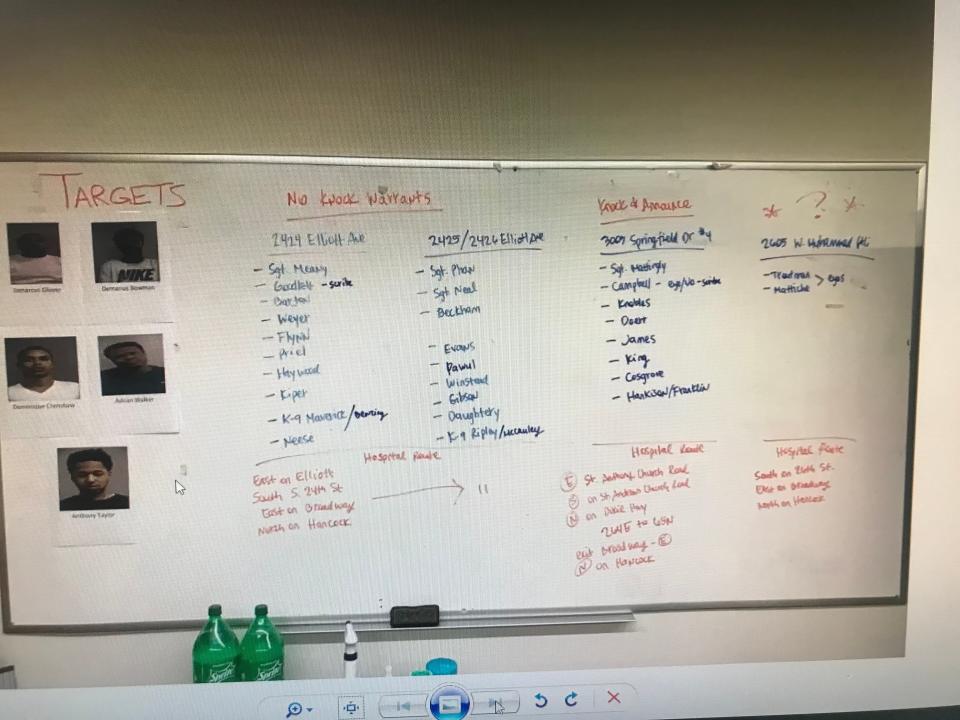
In a recorded statement to investigators, Mattingly said police executed the warrant at Taylor's apartment at the same time as the home on Elliott Avenue.
Taylor's apartment was considered a "soft target" with minimal threats, he said.
"They said they did not believe she had children or animals, but they weren't sure," Mattingly said. "Said she should be there alone because they knew where their target was."
According to court records obtained by The Courier Journal, police served the search warrant for Taylor's apartment at 12:40 a.m. March 13.
Police also executed a search warrant about 10 miles from Taylor's home at a reported drug house on Elliott Avenue in the Russell neighborhood, records show. There, police found Glover and charged him.
Glover's arrest citation lists the time of his offense at 12:40 a.m., the same time the search warrant was executed. But his arrest was listed at 2:43 a.m. March 13, more than two hours later.
In the amended complaint, Aguiar says police initially recorded the time for the search and Glover's arrest as midnight, then later altered the record to add 40 minutes — matching the search time for Taylor's apartment.
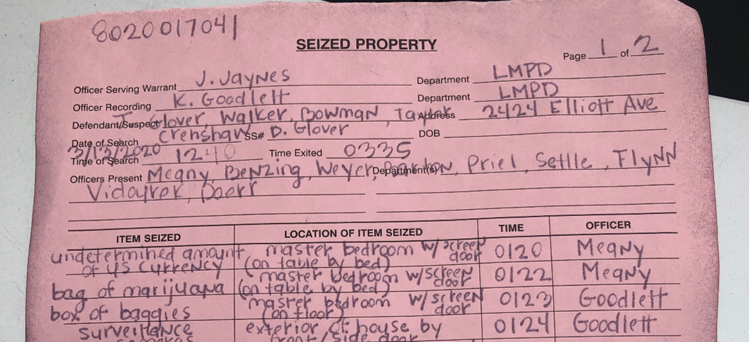
Police Officer Kelly Hanna Goodlett "originally identifies the Elliott search time at '12' on the warrant execution form, only to subsequently add a faint '40' later on to give the impression entry was made around the same time as entry to Breonna's," Aguiar wrote in the document.
A copy of the seized property log turned in to the Circuit Court Clerk's Office after the March 13 search shows the original time of search scratched out and replaced with "0040" on both pages of the document — military time for 12:40 a.m.
The time of the first item seized is logged as 0120 — 1:20 a.m.
In a March 16 email, Goodlett wrote that the Elliott Avenue warrants were carried out at "approximately 0015 hours," or 12:15 a.m. on March 13. Additionally, a K-9 report from Elliott Avenue that night indicates the dog began the search at 12:25 a.m.
Glover told The Courier Journal/USA Today he learned Taylor had died while he was handcuffed outside the Elliott Avenue house and overheard officers and dispatchers on a police radio saying shots had been fired at her apartment address.
Our rating: Likely true
Police documents offer conflicting accounts of whether officers executed the search warrants simultaneously at Elliott Avenue and at Taylor's apartment.
But even if Glover was not in official custody before officers forced their way into Taylor's home, based on statements by Mattingly, police still appeared to know he was at the Elliott Avenue house, as attorneys for Taylor's family assert.
Claim: Taylor was shot while she was asleep in bed
Various social media posts and media reports have said Louisville police gunned down Taylor as she was asleep in bed.
Commonwealth's Attorney Tom Wine played partial recordings of police interviews with Walker during a May 22, 2020, news conference in which Walker told police he and Taylor were watching a movie in bed — it was “watching them more than we were watching it,” he said — when they heard a loud bang at the door, scaring both of them.
Walker said he initially thought it might’ve been Taylor's former boyfriend, but there was no response when Taylor twice called out, “Who is it?”
Then, Walker, saying he was "scared to death," grabbed his legally owned handgun.
'Clearly, I was scared': Police interviews shed light on Breonna Taylor case
Taylor yelled "at the top of her lungs," asking who it was, Walker said in the recording. He said he was asking, too.
They got out of bed and were going toward the apartment's front door when it “comes off its hinges.” Walker fired one shot, unable to see who he was shooting at, he told police.
Police fired 32 times in response, killing Taylor.
Our rating: False
Taylor and Kenneth Walker were in bed when they heard the banging on the apartment door at approximately 12:40 a.m., according to statements Walker made to police.
But they got out of bed before police entered, according to Walker, and Taylor was shot in her hallway, crime scene photos clearly show.
Claim: Taylor was living with a drug dealer
Several social media posts have accused Taylor of living with a drug dealer, insinuating that is why police had targeted her place for a search warrant in their narcotics investigation.
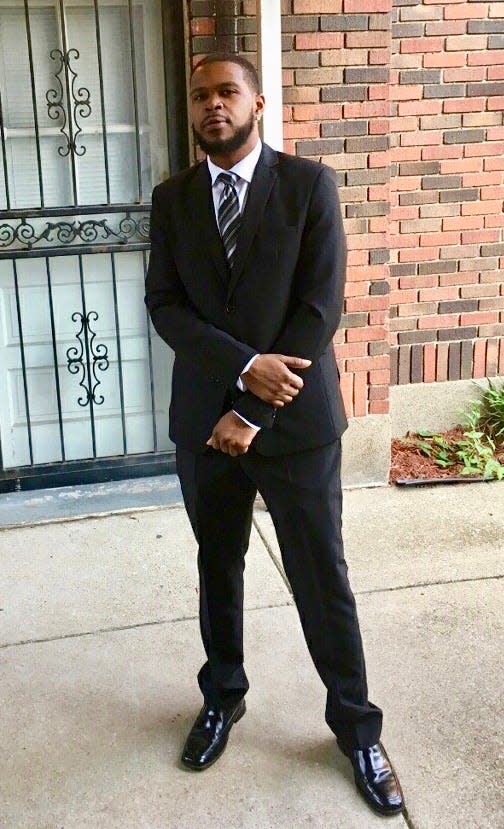
Taylor shared her apartment with her younger sister, Juniyah Palmer. Neither Taylor nor Palmer had any history of drug offenses.
Sam Aguiar, an attorney for Taylor's family, said Taylor had dated Glover, one of the police's main suspects, two years earlier and they maintained a "passive friendship."
Records and recorded jail calls show Glover and Taylor had a more recent contact, but Glover said in a March 13, 2020, call he didn't have "nothing going on with Bre no more."
According to the affidavit detective Jaynes wrote to obtain the search warrant, Glover listed Taylor's apartment as his home address.
Jaynes also wrote that he "verified through a U.S. postal inspector that Jamarcus Glover has been receiving packages" at Taylor's apartment.
But Jaynes later acknowledged to Public Integrity Unit investigators he had asked Mattingly to verify that Taylor was receiving packages from Glover. He didn't do it himself.
And, he said he misunderstood when Mattingly told him that Taylor wasn't receiving packages at her apartment.
In January 2021, Jaynes was fired for violating department procedures surrounding truthfulness and warrant preparation. Interim Chief Yvette Gentry acknowledged Jaynes believed he prepared the warrant in good faith but said he used information that was "not only inaccurate; it was not truthful."
His firing was upheld by the Police Merit Board and he is suing to appeal.
Glover told The Courier Journal and USA Today that Taylor had no involvement in drug trafficking. Glover said he only had clothes and shoes sent to Taylor's apartment because he was afraid they would be stolen if they were left at the Elliott Avenue house.
Walker, Taylor's boyfriend, did not live in the apartment, according to the address listed on his arrest citation. He also has no history of drug offenses and was not named in the search warrant for Taylor's home.
After the shooting, police seized Walker's phone. A forensic analysis reviewed in May — two months after Taylor's death — showed "numerous communications between Walker and other parties confirming Walker’s drug trade," an LMPD investigator wrote in an investigative summary of the case.
However, police statements indicate they did not know Walker would be at Taylor's apartment and had no knowledge about the contents of his phone until months after Taylor was killed.
Steve Romines, Walker's attorney, said LMPD released the phone information in an attempt to "justify what they did after the fact."
Police have never charged Walker with any drug offenses.
Our rating: False
Neither Taylor nor her sister has any drug offenses on their records.
Police wouldn't have known about any alleged involvement that Walker may have had in drug sales until after the shooting, and he was never charged subsequently with any drug offenses.
Additionally, though Taylor and Glover once dated, Glover said they were no longer in touch before her death. There is no evidence Glover was living in Taylor's apartment.
Read more: Board decides ex-cop Myles Cosgrove cannot return to LMPD
Claim: Body-camera footage exists in Taylor's shooting death
Aguiar and Lonita Baker, attorneys for Taylor's family, say more than 120 officers eventually were dispatched to Taylor's South End apartment on Springfield Drive in the early morning hours of March 13.
Hours after the shooting, then-Louisville Police Chief Steve Conrad told news media there was no body-camera footage to share from the shooting.
"This incident was related to the execution of a search warrant by members of our Criminal Interdiction Division, and some of the officers assigned to this division do not wear body-worn video systems," he said at a March 13, 2020, news conference.
Neither Mattingly, Hankison nor Cosgrove were wearing body cameras, officials have said.
Cameron, in his Sept. 23, 2020, news conference, confirmed what Conrad said months earlier: There is "no video or body camera footage of the officers' attempted execution of a search warrant."
Video footage didn't begin until patrol officers arrived, he said.
Attorneys for Taylor's family, however, argue that officers on the scene in the aftermath were wearing body cameras, and they could have captured information that would shed light on Taylor's death.
The city has since released dozens of body camera videos from March 13, which included Walker surrendering to police, SWAT searching Taylor's apartment, Hankison entering the apartment after the shooting and more scenes from the chaotic aftermath.
Additionally, photos taken after the shooting show Detective Anthony James, who was one of seven officers on scene during the shooting, wearing a body camera on the right shoulder of his police vest. James' camera was not activated and he received a one-day suspension in December for violating department body-camera policy.
Read more: If Louisville officials had listened in 2018, there may have been no Breonna Taylor case
Our rating: Partly true
Conrad said Mattingly, Hankison and Cosgrove were not wearing body cameras when they fired into Taylor's apartment and killed her, and Cameron confirmed.
However, other officers at the scene following the shooting had operating body cameras and captured video of the aftermath.
DOJ Investigation: Investigation into Phoenix, Louisville puts all police on notice
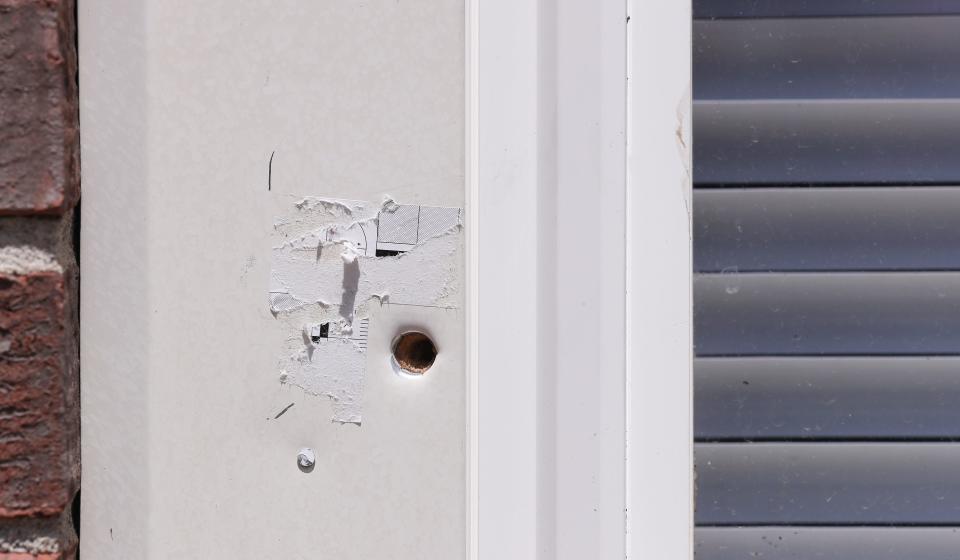
Claim: The officer who was shot was hit by friendly fire
The claim gained traction after national criminal justice reform activist Shaun King tweeted May 14, 2020, "It is now believed that the police officer who got shot in the leg in the shooting of Breonna Taylor was shot by 'friendly fire' from his own officers.
BREAKING: It is now believed that the police officer who got shot in the leg in the shooting of Breonna Taylor was shot by “friendly fire” from his own officers.
His partners were haphazardly emptying their clips and fired shots into 3 different apartments.
They shot him.— Shaun King (@shaunking) May 14, 2020
"His partners were haphazardly emptying their clips … They shot him."
King, a New York-based activist originally from Kentucky, had more than 1.1 million followers on Twitter and more than 2.1 million on Facebook at the time.
Wine, the commonwealth's attorney, said at his May 22, 2020, news conference that Mattingly was shot by Walker, who has admitted he fired from inside the apartment.
The bullet struck Mattingly's femoral artery after piercing his wallet, which Mattingly kept in his left, front pocket, Wine said. Even so, Mattingly nearly bled to death, Wine said.
On Sept. 1, 2020, Romines, one of Walker's attorneys, said his review of the evidence indicates Mattingly was struck by friendly fire.
"We know police are firing wildly from various angles," Romines said. "The timeline and evidence at the scene is more indicative of (police) actually shooting Mattingly than it is Kenny Walker."
Cameron rebutted Romines' theory, saying Mattingly was struck by a 9 mm round. The officers at the scene all carried .40-caliber handguns, he said.
Moreover, a Kentucky State Police ballistics report released by LMPD from its investigative file shows only one 9 mm bullet and casing was found at Taylor's apartment, while 32 cartridge casings from 40-caliber guns were found, which match the number of rounds investigators said the three officers fired.

Our rating: False
In police interviews and through his attorney, Walker has not disputed firing one round inside the apartment.
A Kentucky State Police ballistics report supports Wine and Cameron's assertion Walker's bullet struck Mattingly.
However, attempted murder and assault charges against Walker for shooting Mattingly were permanently dismissed in March 2021. Wine's office said "no new relevant information" from the investigation supported charges against Walker.
Civil suit: Ex-LMPD cop shot in Breonna Taylor raid claims attorney defamed him in media
Claim: Breonna Taylor had a rifle and shot at police
In the initial aftermath of the March 13, 2020, shooting, officers asked Walker who was shooting from inside the apartment. Walker said it was Taylor.
Walker soon backtracked, telling investigators he panicked and admitted he fired one shot from his Glock handgun.
"I had no reason to say it, like I say, my gun is legal and everything," he said. "Clearly, I was scared. I don't know."
However, the narrative that Taylor was the shooter soon spread within LMPD, and it persisted on social media. Some police documents, including the warrant to search Taylor's apartment after the shooting, listed her as the suspect who shot the officer.
SWAT officers responding to Taylor's apartment were told that Taylor may have been the shooter, and at least two officers told then-Chief Conrad that same night that Taylor, armed with a rifle, had opened fire on officers.
Cameron, speaking on a talk radio program Oct. 9, 2020, said Taylor definitely was not the shooter.
"I think it is very well understood that Mr. Walker fired the weapon, and he had made that statement," Cameron said. "Ms. Taylor was a good woman, and I'll leave that there as it relates to her."
Our rating: False
Despite initially saying Taylor was the shooter, Walker quickly recanted and admitted firing one shot after police used a battering ram to enter Taylor's apartment.
Neither he nor Taylor was armed with a rifle or long gun of any kind — he had his Glock 9 mm handgun.
Taylor family settlement: Louisville promised police reform after Breonna Taylor's death. Here's what it delivered
Claim: Taylor works as an EMT
On May 11, 2020, Crump, who has represented several high-profile clients around the country in police shootings, issued a news release saying he was joining the case of an "EMT killed in a bungled police raid."
Several local and national media outlets, including The Courier Journal, also initially reported that Taylor was an emergency medical technician.
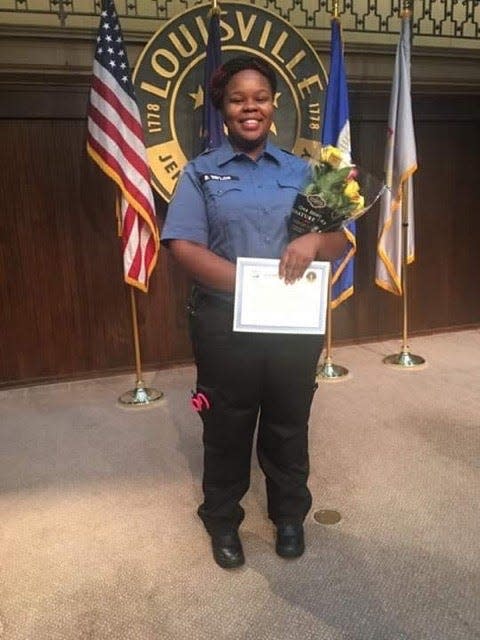
Our rating: Partially true
Taylor joined the city as an EMT recruit in January 2016, became a full EMT by June and left the Metro Government in November 2016.
The Kentucky licensure agency says Taylor's license was never suspended, and there is no disciplinary action in her file. However, her EMS certification expired March 31, 2018, according to the National Registry of Emergency Medical Technicians.
Local attorneys for Taylor's family have clarified that she was working as an ER technician at two area hospitals at the time of her death, with aspirations of becoming a nurse.
U of L Health, where Taylor worked at Medical Center East, set up a scholarship in her honor.
Department of Justice: How investigations compare in Louisville and Phoenix
Claim: Taylor was shot eight times by police
In the civil lawsuit filed in April against the LMPD officers who fired their weapons and killed Taylor, attorneys for her family wrote that she was "shot at least eight times by the officers' gunfire and died as a result."
Since then, it had been widely reported, including in The Courier Journal, that Taylor was shot eight times.
Taylor's death certificate from the state Registrar of Vital Statistics lists her cause of death as "multiple (5) gunshot wounds of the body."
On Sept. 23, 2020, Cameron said the investigation showed Taylor was shot six times. He noted the sixth "projectile" was lodged in one of Taylor's feet.
A Kentucky State Police analysis "did not identify" which of the three officers fired the fatal shot, but the FBI crime lab concluded it came from Cosgrove. Cameron said this creates a "reasonable doubt" of who fired the fatal shot.
Cameron noted there was "nothing conclusive to say" that any of Hankison's 10 shots hit Taylor.
Our rating: False
Taylor's official cause of death, as determined by the investigation, was six gunshot wounds to the body. Only one shot, though, was determined to be fatal.
Jefferson Square Park: ‘You need to be reminded of Breonna’: How a tiny city park became the heart of a movement
Reach Tessa Duvall at [email protected] and 502-582-4059. Twitter: @TessaDuvall.
This article originally appeared on Louisville Courier Journal: Breonna Taylor shooting fact check: 9 things people often get wrong
